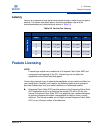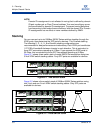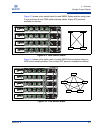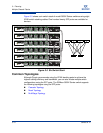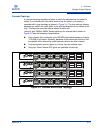
3 – Planning
Multiple Chassis Fabrics
3-6 59265-02 A
S
Fabric Security provides access to the following security tools (refer to
“Security” on page 3-15 for more information):
Security for Ethernet connections using the Secure Socket Layer
(SSL) protocol and Telnet connections using the Secure Shell (SSH)
protocol
Device and switch authorization and authentication using the
Challenge Handshake Authentication Protocol (CHAP).
Remote authentication of users and devices using the Remote
Authentication Dial-In User Service (RADIUS)
SANdoctor provides access to the following tools:
Fibre Channel connection verification (Fcping CLI command)
Fibre Channel route tracing (Fctrace CLI command)
Transceiver diagnostic information (Show Media CLI command).
Port Activation activates additional SFP ports for a total of 16, 20, or 24
ports.
20-Gbps license enables the XPAK ports to transmit and receive at
25.5-Gbps instead of the default 12.75-Gbps.
Upgrading a switch is not disruptive, nor does it require a switch reset. To order a
license key, contact your switch distributor or your authorized reseller. Refer to
“Installing Feature License Keys” on page 4-20 for information about installing a
license key.
Multiple Chassis Fabrics
By connecting switches together you can expand the number of available ports for
devices. Each switch in the fabric is identified by a unique domain ID, and the
fabric can automatically resolve domain ID conflicts. Because the Fibre Channel
ports are self-configuring, you can connect SANbox 5800V Series switches
together in a wide variety of topologies.
You can connect up to six SANbox 5800V Series switches together through the
XPAK ports, thus preserving the SFP ports for devices. This is called stacking.
SANbox 5800V Series switches divide the XPAK port buffer to balance traffic
across the connection. The XPAK ports operate with any standard XPAK
interface. You can also connect SANbox 5800V Series switches with other
switches through the SFP ports in a wide variety of topologies. Consider your
topology and cabling requirements.










